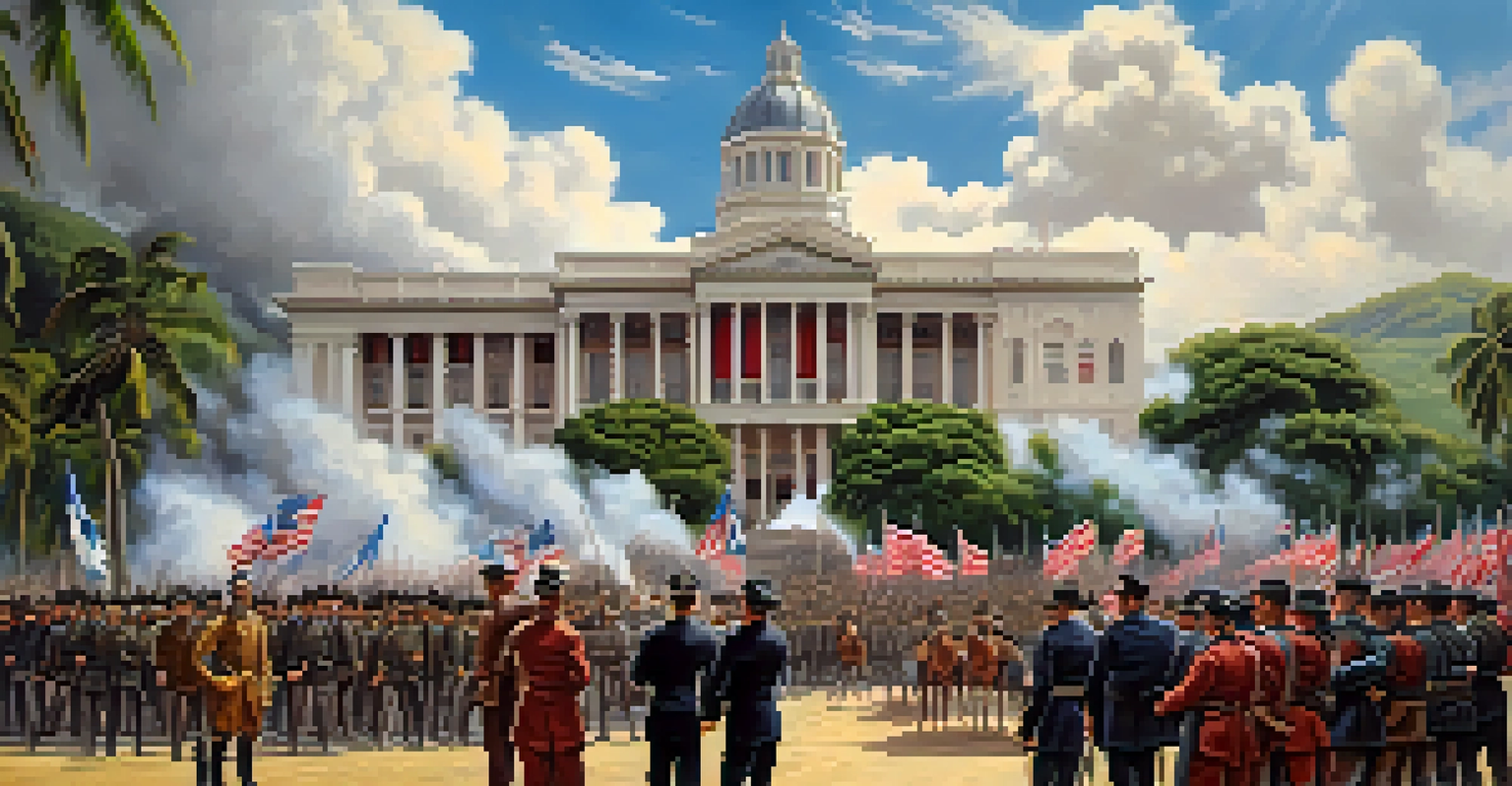The Overthrow of Queen Lili‘uokalani: A Pivotal Moment

The Rise of Queen Lili‘uokalani and Her Vision
Queen Lili‘uokalani became Hawaii's first and only queen in 1891, representing a significant shift in leadership. Her vision for Hawaii was one of restoring the power and rights of native Hawaiians, which had been eroded by foreign influence. Lili‘uokalani aimed to establish a government that reflected the values and needs of her people, focusing on sovereignty and cultural integrity.
The greatest glory in living lies not in never falling, but in rising every time we fall.
Her determination to implement a new constitution, known as the 'Hawaii for Hawaiians' policy, was met with fierce opposition from foreign businessmen and sugar planters. They perceived her reforms as a direct threat to their control over Hawaii's economy and political landscape. This tension set the stage for a conflict that would ultimately alter the course of Hawaiian history.
Lili‘uokalani's vision embodied hope for many Hawaiians, emphasizing self-governance and a return to traditional values. However, the growing discontent among powerful interests foreshadowed the challenges she would face. The queen's aspirations would soon collide with the harsh realities of colonial ambitions.
The Role of American Interests in Hawaii
American business interests had long been entrenched in Hawaii, especially in the lucrative sugar industry. These businesses thrived under the Reciprocity Treaty of 1875, which allowed Hawaiian sugar to enter the U.S. market duty-free. As a result, American planters grew increasingly powerful and influential, often overshadowing the native government.

The presence of these foreign interests created a complex web of political intrigue and economic dependence. Many American planters formed a political party, known as the 'Hawaiian League,' that aimed to overthrow the monarchy and establish a republic. Their agenda was fueled by a desire to maintain their economic dominance and prevent any reforms that might threaten their profits.
Lili‘uokalani's Vision for Hawaii
Queen Lili‘uokalani aimed to restore native Hawaiian sovereignty and cultural integrity amidst foreign influence.
In this context, the conflict between the monarchy and American interests escalated, leading to a precarious situation for Queen Lili‘uokalani. The queen's attempts to assert her authority were met with organized opposition from the Hawaiian League, illustrating the growing divide between the monarchy and foreign powers. This rivalry would soon culminate in a significant political upheaval.
The 1893 Coup: A Turning Point
On January 14, 1893, the tensions reached a boiling point when a coup was orchestrated against Queen Lili‘uokalani. Armed with support from the U.S. military, the Hawaiian League seized control of key government buildings, effectively ousting the queen. This dramatic turn of events shocked many Hawaiians who had hoped for a peaceful resolution.
History is not a burden on the memory but an illumination of the soul.
The coup leaders quickly established a provisional government, declaring their intention to create a republic. They justified their actions by arguing that they were protecting American interests and promoting democracy in Hawaii. However, their motives were deeply rooted in self-interest and a desire to eliminate the queen’s sovereignty.
Lili‘uokalani's overthrow marked a pivotal moment in Hawaiian history, as it represented the culmination of decades of foreign intervention and manipulation. The queen's dreams for a sovereign Hawaii were dashed, setting the stage for further U.S. involvement in the islands. The coup not only altered the political landscape but also ignited a national conversation about identity and autonomy.
The Role of the United States in the Overthrow
The U.S. government's involvement in the overthrow of Queen Lili‘uokalani was a significant factor in the coup's success. American Minister to Hawaii, John L. Stevens, played a crucial role by providing support to the coup leaders. His actions were a clear indication of the U.S. government's interest in the islands, driven by economic and strategic motives.
This intervention was framed as a desire to protect American citizens and interests, but it also reflected a broader imperialistic agenda. The U.S. was increasingly looking to expand its influence in the Pacific, and Hawaii was seen as a vital stepping stone. This perspective ultimately led to the annexation of Hawaii in 1898, further entrenching American control.
Coup and U.S. Intervention
The 1893 coup against Lili‘uokalani, supported by U.S. interests, marked a significant turning point in Hawaiian history.
The role of the U.S. in the overthrow has sparked ongoing debates about sovereignty, imperialism, and justice. While some viewed the intervention as necessary, many Hawaiians saw it as an act of aggression against their homeland. This complex historical narrative continues to shape discussions about Hawaii's identity and relationship with the U.S.
Queen Lili‘uokalani's Response and Legacy
After her overthrow, Queen Lili‘uokalani displayed remarkable resilience and determination. She sought to regain her throne through legal means and appealed to the U.S. government, highlighting the injustices faced by her people. Although her efforts were ultimately unsuccessful, her actions underscored her commitment to the Hawaiian people and their rights.
In the years that followed, Lili‘uokalani became a symbol of resistance against colonialism. She used her voice to advocate for the rights of native Hawaiians and worked tirelessly to preserve Hawaiian culture and traditions. Her legacy is a testament to the struggles faced by indigenous peoples in the face of colonial powers.
Lili‘uokalani's story resonates deeply within Hawaiian culture today, reminding people of the importance of sovereignty and self-determination. Her music, writings, and advocacy continue to inspire movements for justice and recognition of Hawaiian rights. The queen's legacy is a powerful reminder of the resilience of a people and the ongoing fight for their identity.
The Aftermath: Hawaii’s Path to Statehood
Following the overthrow, Hawaii experienced significant political changes that paved the way for its eventual annexation by the United States. The provisional government transitioned into a republic in 1894, solidifying American control over the islands. This shift marked the beginning of a new era, one characterized by increased American influence and a diminishing role for native governance.
The annexation of Hawaii in 1898 was met with mixed reactions. While some welcomed the economic opportunities that came with being part of the U.S., many native Hawaiians felt their rights and culture were being further eroded. The loss of sovereignty had lasting repercussions, leading to a struggle for identity and recognition that persists today.
Legacy of Resistance and Identity
Lili‘uokalani's legacy continues to inspire movements for Hawaiian rights and cultural preservation today.
Hawaii's journey to statehood in 1959 marked another significant milestone, but the path was fraught with challenges. The legacy of Queen Lili‘uokalani and the events of 1893 continue to resonate in discussions about race, identity, and historical justice. Understanding this history is vital for appreciating the complexities of Hawaii's place within the United States.
Reflections on Colonialism and Identity
The overthrow of Queen Lili‘uokalani serves as a poignant reminder of the impacts of colonialism on indigenous populations. It highlights the struggle for sovereignty and the ongoing quest for identity among native Hawaiians. This history raises important questions about the nature of power, control, and cultural preservation in the modern world.
In reflecting on this pivotal moment, we recognize the resilience of native peoples in the face of oppression. The legacy of Lili‘uokalani inspires contemporary movements advocating for cultural revival and recognition of native rights. Her life and work continue to empower new generations to embrace their heritage and challenge injustices.

As we engage with this history, it becomes clear that understanding the past is crucial for fostering a more inclusive future. The story of Queen Lili‘uokalani and her fight for sovereignty encourages us to reflect on the values of justice, equality, and respect for all cultures. It is a powerful call to honor and celebrate the richness of Hawaiian identity.